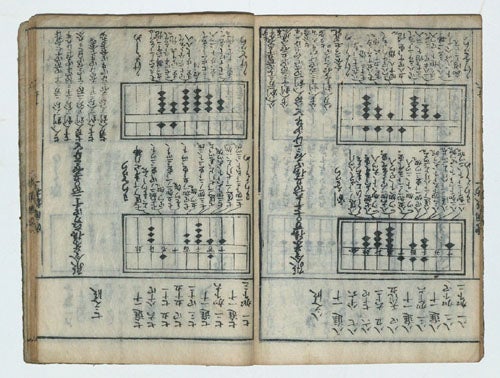
Zōho Sanpō ketsugishō, 5 kan.
Half folio, 20.6 x 14.3 cm. Printer’s colophon: “First year of Jōkyō (1684), [Kyoto] Teramachi Street, below (i.e., south of) Nijo [Street], Nakamura Gohei.” Japanese xylographic edition Columns per page, irregular. Illustrated. Fukuro-toji (i.e. thread) binding, uniform original wrappers with printed title labels reading Tōsho Sanpō ketsugishō. 5 vols. 1: 1-2 (preface, dated 1684), 3-4 (table of contents), 5-6 (preface, undated), 7-46 ff. 2:1-2 (table of contents), 3-42 ff. 3: 1-2 (table of contents), 1-65 ff. 4:1-42 ff. 5:1, 1 (table of contents), 1-65 ff. Modern, brocade folding case. Slight wear to edges of wrappers, with some creasing. Occasional spotting on the leaves. Extremely well preserved, supple copy in original binding, with excellent impressions.
Extremely rare copy of a classic work produced in 1661 during Japan’s intellectual awakening by the important mathematician Isomura Yoshinori (d. 1710). This much enlarged third edition (1684) includes new uses for pi, such as novel calculations of the surface of a sphere. It solves other practical problems, for instance, the best means of surveying difficult landscapes, and the determination of the volumes of solids. These pursuits are illustrated in a Western style with Eastern inflections. The surveying diagrams in particular could be copied directly from a Western manual, if it were not for local touches, such as the clearly-depicted bamboo canes the surveyors use to calculate the height of a tall willow or faraway misty peak.
Isomura was known as “master of the abacus.” He taught in a mathematical tradition that sharpened many notable minds over the centuries (including Machiavelli in 15th century Italy). Indeed, Japanese mathematics advanced so far during the seventeenth century that Isomura could complete the “rough approach to an integral calculus” in this book. A similar type of calculus would be developed in Europe by Leibniz. Isomura was also fascinated with the properties and combinations of numbers in “magic squares, magic circles and magic wheels.” One experimental use of these formats formed the basis for the now popular puzzle game Sudoku, a discovery usually attributed to the 18th-century Swiss mathematician Leonhard Euler. Isomura’s abacus and proto-Sudoku grids are illustrated throughout the volume, bringing an even more modern aspect to its design. This cutting-edge mathematical work demonstrates the graphical influence of the West, just as it absorbs and improves upon Western mathematics. A stunning copy of an extremely rare and important text.
* D.E. Smith and Y. Mikami, A History of Japanese Mathematics (1914) I, p 437; this edn. held in US at LC only.
Price: $12,500.00
